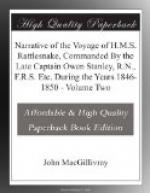ARRIVE IN SIGHT OF NEW GUINEA.
August 12th.
We saw in the distance part of the high land of New Guinea in the neighbourhood of where its south-east cape has been conjectured to be, and approached within a few miles of the Dumoulin* Islands, a group of four rocky isles, the westernmost of which is 400 feet high, and less than a mile in length; there are besides five rocks, some of considerable size.
(Footnote. The hydrographical engineer attached to D’Urville’s last expedition, and the constructor of most of the charts published in the Hydrographical Atlas of Voyage au Pole Sud etc.)
DUMOULIN ISLANDS.
The Dumoulin Isles are inhabited, and appear fertile—they are tolerably well-wooded with small trees and a sprinkling of cocoa-palms. In standing off for the night, the water suddenly shoaled from no bottom with 80 fathoms to casts of 16 and 12 fathoms, of coral, and sand and shells, and then deepened again as we went out. One is inclined to suspect that this may be a submarine extension of the barrier reef.
The Bramble meanwhile had been ordered in to look for anchorage, and found it under the lee of the largest island in 25 fathoms. She remained in that neighbourhood for several days while we were beating about at sea. Several of the Dumoulin Islands proved to be inhabited, and the natives exhibited no hostile feeling towards the Bramble’s people. A specimen of the rock, taken from the shore and given me by Lieutenant Yule, is a very curious siliceous breccia; when viewed from the sea I had observed the cliffs to exhibit horizontal and vertical fissures—apparently lines of cleavage—as I had seen assumed on various occasions during our last cruise by granite and porphyry. This, at least, indicated a great approaching change in the geological structure of the New Guinea Islands, contrasted with those of the Louisiade Group which had come under our observation.
CHAPTER 1.7.
Brumer Islands.
Catamarans and Canoes.
Friendly relations with the Natives of New Guinea.
Are well received at their Village.
Tatooing and Dress of the Women.
The Huts described.
Large Canoe from the Mainland.
Tassai ladies return our visit.
The Natives described.
Their Weapons, Ornaments, Food, etc.
Cul de Sac de l’Orangerie, and Communication
with the Natives.
Redscar Bay and its Inhabitants.
Leave the Coast of New Guinea.
Arrive at Cape York.
BRUMER ISLANDS.
August 17th.
We are once more comfortably at anchor after many dreary days at sea of thick blowing weather* spent in sailing backwards and forwards, daily tantalised by the sight of land, which was approached only that we might stand off again for the night. Yesterday afternoon the Bramble was seen coming out from under the largest of the Brumer Islands, and on her making the usual signal for good anchorage, we followed her in and brought up after sunset in 35 fathoms, mud, about a mile from the shore.




